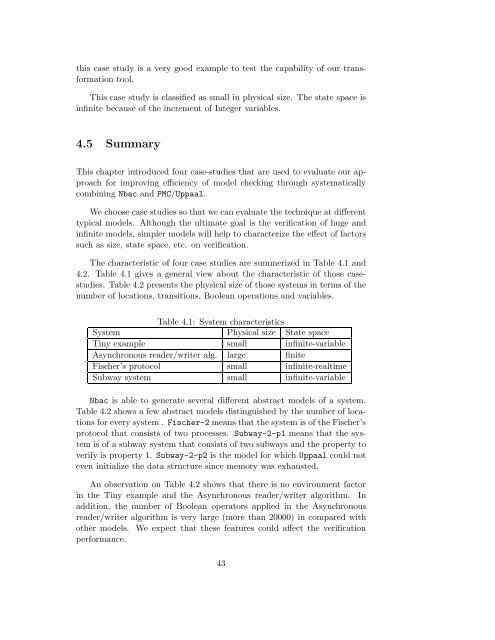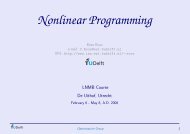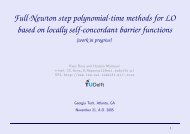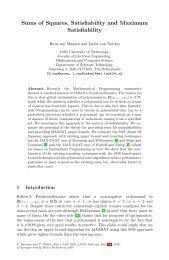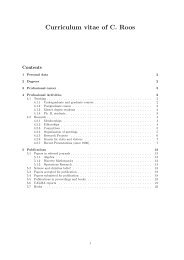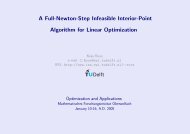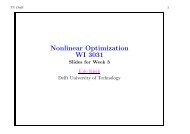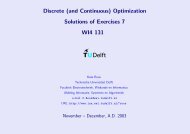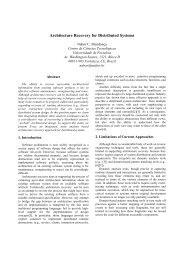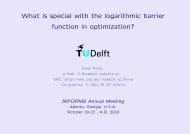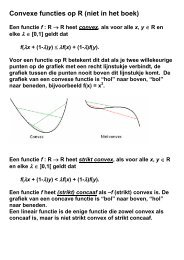On improving efficiency of model checking through systematically ...
On improving efficiency of model checking through systematically ...
On improving efficiency of model checking through systematically ...
You also want an ePaper? Increase the reach of your titles
YUMPU automatically turns print PDFs into web optimized ePapers that Google loves.
this case study is a very good example to test the capability <strong>of</strong> our transformation<br />
tool.<br />
This case study is classified as small in physical size. The state space is<br />
infinite because <strong>of</strong> the increment <strong>of</strong> Integer variables.<br />
4.5 Summary<br />
This chapter introduced four case-studies that are used to evaluate our approach<br />
for <strong>improving</strong> <strong>efficiency</strong> <strong>of</strong> <strong>model</strong> <strong>checking</strong> <strong>through</strong> <strong>systematically</strong><br />
combining Nbac and PMC/Uppaal.<br />
We choose case studies so that we can evaluate the technique at different<br />
typical <strong>model</strong>s. Although the ultimate goal is the verification <strong>of</strong> huge and<br />
infinite <strong>model</strong>s, simpler <strong>model</strong>s will help to characterize the effect <strong>of</strong> factors<br />
such as size, state space, etc. on verification.<br />
The characteristic <strong>of</strong> four case studies are summerized in Table 4.1 and<br />
4.2. Table 4.1 gives a general view about the characteristic <strong>of</strong> those casestudies.<br />
Table 4.2 presents the physical size <strong>of</strong> those systems in terms <strong>of</strong> the<br />
number <strong>of</strong> locations, transitions, Boolean operations and variables.<br />
Table 4.1: System characteristics<br />
System Physical size State space<br />
Tiny example small infinite-variable<br />
Asynchronous reader/writer alg. large finite<br />
Fischer’s protocol small infinite-realtime<br />
Subway system small infinite-variable<br />
Nbac is able to generate several different abstract <strong>model</strong>s <strong>of</strong> a system.<br />
Table 4.2 shows a few abstract <strong>model</strong>s distinguished by the number <strong>of</strong> locations<br />
for every system . Fischer-2 means that the system is <strong>of</strong> the Fischer’s<br />
protocol that consists <strong>of</strong> two processes. Subway-2-p1 means that the system<br />
is <strong>of</strong> a subway system that consists <strong>of</strong> two subways and the property to<br />
verify is property 1. Subway-2-p2 is the <strong>model</strong> for which Uppaal could not<br />
even initialize the data structure since memory was exhausted.<br />
An observation on Table 4.2 shows that there is no environment factor<br />
in the Tiny example and the Asynchronous reader/writer algorithm. In<br />
addition, the number <strong>of</strong> Boolean operators applied in the Asynchronous<br />
reader/writer algorithm is very large (more than 20000) in compared with<br />
other <strong>model</strong>s. We expect that these features could affect the verification<br />
performance.<br />
43


